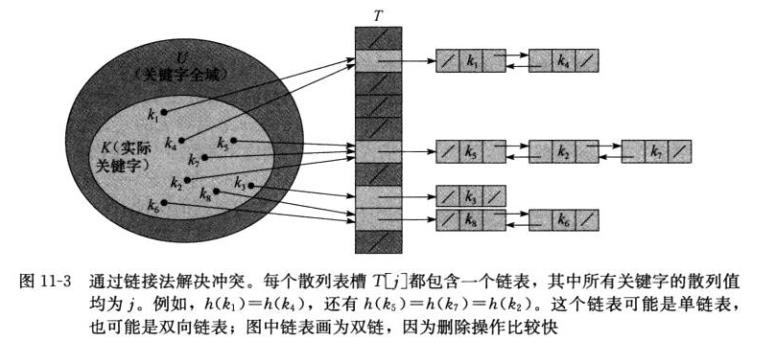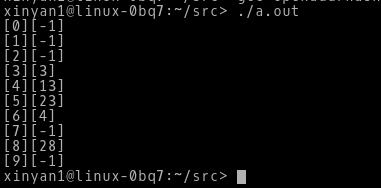散列表链地址法查找成功的平均查找长度怎么计算
Posted
tags:
篇首语:本文由小常识网(cha138.com)小编为大家整理,主要介绍了散列表链地址法查找成功的平均查找长度怎么计算相关的知识,希望对你有一定的参考价值。
一、举个例子:数组长度10 散列函数x%7。
如 13 先计算散列 13%7 = 6 如果没有冲突的话会被放在第六个格子里。
现在散列表中 : (x为已经有一个元素 o表示空)
0 x
1 x
2 x
3 o
4 o
5 x
6 x
7 x
8 x
9 o
计算失败概率 :
思路如下,任意出现一个数字(概率均等)经过hash函数以后 0 ~ 6的概率均等 现在假设 输入一个数字 hash计算结果是1,去1里查找,结果发现位置1(接下来简称pos1)不是目标元素(查找失败),于是线性探查找到了2(还是失败)然后找三,发现没有,于是确定所找元素不在哈希表里。
以上是查找过程,以此类推失败的情况下需要找 4,3,2,1,1,5,4 (7和7以后没得找,因为任何数膜7都<7)失败概率。
二、查找不成功的次数表如下表所示
Key 7 8 30 11 18 9 14
Count 3 2 1 2 1 5
所以ASLunsuccess= (3+2+1+2+1+5+4)/ 7 = 18/7。
扩展资料:
散列函数
在进行查找时,在记录的存储位置与它的关键字之间建立一个确定的对应关系h,以线性表中每个元素的关键字K为自变量,通过函数h(K)计算出该元素的存储位置,我们将h函数称为散列函数或哈希函数。h(K)的值称为散列地址或哈希地址。
例:
假定一个线性表为A=(18,75,60,43,54,90,46),选取散列函数为:
h(K)=K%m 取m=13
则得每个元素散列地址:
h(18)=18 % 13=5 h(75)=75 % 13=10 h(60)=60 % 13=8 h(43)=43 % 13=4
h(54)=54 % 13=2 h(90)=90 % 13=12 h(46)=46 % 13=7
参考资料来源:百度百科-散列查找
参考技术A 举个例子吧 数组长度10 散列函数x%7如 13 先计算散列 13%7 = 6 如果没有冲突的话会被放在第六个格子里
现在散列表中 : (x为已经有一个元素 o表示空)
0 x
1 x
2 x
3 o
4 o
5 x
6 x
7 x
8 x
9 o
计算失败概率 : 思路如下,任意出现一个数字(概率均等)经过hash函数以后 0 ~ 6的概率均等 现在假设 输入一个数字 hash计算结果是1,去1里查找,结果发现位置1(接下来简称pos1)不是目标元素(查找失败),于是线性探查找到了2(还是失败)然后找三,发现没有,于是确定所找元素不在哈希表里,以上是查找过程,以此类推失败的情况下需要找 4,3,2,1,1,5,4 (7和7以后没得找,因为任何数膜7都<7)失败概率 参考技术B 举个例子吧 数组长度10 散列函数x%7
如 13 先计算散列 13%7 = 6 如果没有冲突的话会被放在第六个格子里
现在散列表中 : (x为已经有一个元素 o表示空)
0 x
1 x
2 x
3 o
4 o
5 x
6 x
7 x
8 x
9 o
计算失败概率 : 思路如下,任意出现一个数字(概率均等)经过hash函数以后 0 ~ 6的概率均等 现在假设 输入一个数字 hash计算结果是1,去1里查找,结果发现位置1(接下来简称pos1)不是目标元素(查找失败),于是线性探查找到了2(还是失败)然后找三,发现没有,于是确定所找元素不在哈希表里,以上是查找过程,以此类推失败的情况下需要找 4,3,2,1,1,5,4 (7和7以后没得找,因为任何数膜7都<7)失败概率~~~自己算吧~本回答被提问者和网友采纳
散列表
一、基本概念
关键字的全域为集合U,待散列的关键字集合为K,散列表的存储需求为O(K),同时针对平均情况的查找时间为O(1)。关键字k被存放在槽h(k)中,即利用散列函数h,由关键字k计算出槽的位置,h将U映射到散列表T[0...m1]的槽位上。
冲突:两个关键字可能映射到同一个槽中。
解决冲突:链接法、开放寻址法
二、通过链接法解决冲突
把散列到同一槽中的所有元素都放在一个链表中,如下图所示。

1 /* 通过链接法解决冲突的散列表 2 链接链表,使用双向、非循环、非排序方式 3 */ 4 #include <stdio.h> 5 #include <stdlib.h> 6 7 #define HASH_SIZE 10 8 #define ARRAY_SIZE 15 9 10 typedef struct object { 11 int key; 12 struct object *prev,*next; 13 }object_s; 14 15 typedef struct chainedhash { 16 object_s *ptable[HASH_SIZE]; 17 }chainedhash_s; 18 19 //函数声明 20 void chained_hash_init(chainedhash_s *phash); 21 void chained_hash_insert(chainedhash_s *phash, int key); 22 object_s *chained_hash_search(chainedhash_s *phash, int key); 23 void chained_hash_delete(chainedhash_s *phash, object_s *pobj); 24 void chained_hash_print(chainedhash_s *phash); 25 int hash_function(int key); 26 27 int main(void) 28 { 29 chainedhash_s hash; 30 int index; 31 32 chained_hash_init(&hash); 33 34 for(index=0;index<ARRAY_SIZE; index++) { 35 chained_hash_insert(&hash, index); 36 } 37 38 chained_hash_print(&hash); 39 return 0; 40 } 41 42 void chained_hash_init(chainedhash_s *phash) 43 { 44 int i; 45 for(i=0; i<HASH_SIZE; i++) 46 phash->ptable[i] = NULL; 47 } 48 49 void chained_hash_insert(chainedhash_s *phash, int key) 50 { 51 object_s *pobj; 52 int index; 53 54 pobj = (object_s*)malloc(sizeof(object_s)); 55 pobj->key = key; 56 index = hash_function(key); 57 58 // 从链表头插入 59 if(phash->ptable[index] != NULL) 60 phash->ptable[index]->prev = pobj; 61 pobj->prev = NULL; 62 pobj->next = phash->ptable[index]; 63 phash->ptable[index] = pobj; 64 65 return; 66 } 67 68 object_s *chained_hash_search(chainedhash_s *phash, int key) 69 { 70 int index; 71 object_s *pobj; 72 73 index = hash_function(key); 74 for(pobj=phash->ptable[index]; pobj!=NULL; pobj=pobj->next) { 75 if(pobj->key == key) 76 return pobj; 77 } 78 79 return NULL; 80 } 81 82 void chained_hash_delete(chainedhash_s *phash, object_s *pobj) 83 { 84 int index; 85 index = hash_function(pobj->key); 86 87 if(phash->ptable[index] == pobj) { 88 phash->ptable[index] = pobj->next; 89 if(pobj->next != NULL) 90 pobj->next->prev = NULL; 91 } else { 92 pobj->prev->next = pobj->next; 93 if(pobj->next != NULL) 94 pobj->next->prev = pobj->prev; 95 } 96 free(pobj); 97 } 98 99 void chained_hash_print(chainedhash_s *phash) 100 { 101 int index; 102 object_s *pobj; 103 104 for(index=0; index<HASH_SIZE; index++) { 105 printf("%d:",index); 106 for(pobj=phash->ptable[index]; pobj!=NULL; pobj=pobj->next) { 107 printf("%d ",pobj->key); 108 } 109 printf("\\n"); 110 } 111 } 112 113 int hash_function(int key) 114 { 115 return key%10; 116 }
三、开放寻址法解决冲突
在开放寻址法中,当要插入一个元素时,可以连续地检查(或称探查)散列表的各项,直到找到一个空槽来放置待插入的关键字时为止。在必须删除关键字的应用中,往往采用链表法来解决碰撞。若采用一致散列,则search、insert时间复杂度都为O(1)
探查序列有三种
1.线性探查。 h(k,i)=(h\'(k) + i) mod m, i=0,1,...,m-1 ;m种不同的探查序列
2.二次探查。 h(k,i) = (h\'(k) + c1*i + c*i^2) mod m ; m种不同的探查序列
3.双重散列。h(k,i) = (h1(k) + i*h2*k)) mod m ; m^2种不同的探查序列
1 // 散列表,使用开发寻址法(线性探测)解决冲突 2 #include<stdio.h> 3 4 #define HASH_SIZE 10 5 #define ARRAY_SIZE 5 6 #define FAIL -1 7 8 int hashtable[HASH_SIZE]; 9 10 // 函数声明 11 int insert_hash(int hasht[], int key); 12 int search_hash(int hasht[], int key); 13 void init_hash(int hasht[]); 14 int hash_function(int key, int i); 15 16 int main(void) 17 { 18 int array[ARRAY_SIZE]={3,13,23,4,28}; 19 int i; 20 21 init_hash(hashtable); 22 23 for(i=0;i<ARRAY_SIZE;i++) 24 insert_hash(hashtable, array[i]); 25 26 for(i=0; i<HASH_SIZE; i++) 27 printf("[%d][%d]\\n",i,hashtable[i]); 28 } 29 30 int insert_hash(int hasht[], int key) 31 { 32 int i,j; 33 34 for(i=0;i<HASH_SIZE;i++) { 35 j=hash_function(key, i); 36 if(hasht[j] == -1) { 37 hasht[j]=key; 38 return j; 39 } 40 } 41 printf("hash table overflow\\n"); 42 return FAIL; 43 } 44 45 int search_hash(int hasht[], int key) 46 { 47 int i,j; 48 49 for(i=0; i<HASH_SIZE; i++) { 50 j=hash_function(key, i); 51 if(hasht[j] == key) { 52 return j; 53 } 54 if(-1 == hasht[j]) 55 break; 56 } 57 58 return FAIL; 59 } 60 61 void init_hash(int hasht[]) 62 { 63 int i; 64 for(i=0; i<HASH_SIZE; i++) 65 hasht[i]=-1; 66 } 67 68 int hash_function(int key, int i) 69 { 70 return (key%HASH_SIZE+i)%HASH_SIZE; 71 }
测试结果如下:

以上是关于散列表链地址法查找成功的平均查找长度怎么计算的主要内容,如果未能解决你的问题,请参考以下文章